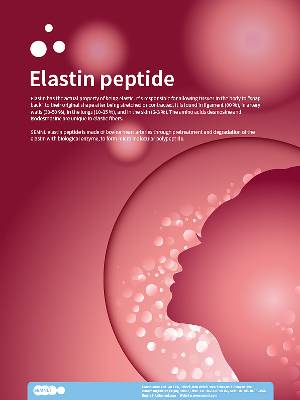Nov. 21, 2020
Elastin and Collagen are present in the dermis layer of the skin. The dermis is located below our epidermis and above the subcutaneous tissue. Its thickness is about 10 times thicker than the epidermis. Its entire function is to support our entire skin and provide nourishment and nutrition.
Where do elastin and collagen come from? Only by finding the source and letting the place where these two are produced can be produced normally, will it be more meaningful for skin care!
In the dermis, there is a substance called fibroblasts, fibroblasts. Its biggest function is to secrete and synthesize elastin, collagen, hyaluronic acid and proteoglycan! It can be said whether the skin is good, tender or not, it depends on the fibroblasts! So to put it simply: Fibroblasts are the processing factories of collagen, elastin and hyaluronic acid. Only their vitality and proliferation can be continuously produced.
When we were young, our skin had sufficient fiber buds and strong vitality. At this time, the face was also the most resistant to creation. With heavy makeup, various expressions, staying up late, smoking and drinking, and sleeping, the skin became better. But with age, the number of fibroblasts decreases, the vitality decreases, and the mutations, natural collagen, Elastin and hyaluronic acid are less, so you understand? In this way, the marks on the face must be left behind, such as wrinkles, stains, and dark yellow. . . . . .

Elastin Peptides
Journal of the Japanese Society of Food Science and Technology published a research paper in 2011 that a small daily intake of elastin peptides can significantly increase skin elasticity. Many studies have also shown that oral intake of appropriate elastin peptides can increase the number of fibroblasts, improve skin elasticity, reduce wrinkles, smooth skin, and relieve dry skin.
Experiments also show that Elastin Peptides can stimulate the viability and proliferation of fibroblasts, thereby secreting and synthesizing elastin, collagen, and hyaluronic acid, which play a good role in moisturizing, anti-wrinkle, repairing damaged barriers and promoting wound healing. At the same time, the metalloprotease inhibitory peptide in the elastin peptide can inhibit the metalloprotease activity, thereby reducing the loss of collagen, so as to maintain the level of collagen.
Matrix metalloproteinases are widely present in the body. Under physiological conditions, there are natural inhibitors of elastase degradation that are absolutely dominant in quantity, resulting in a dynamic balance between elastase and elastase inhibitors. However, when the body is aging or has genetic defects, long-term ultraviolet radiation, inflammation and other pathological conditions, the concentration of elastase degradation inhibitors decreases, or elastase activity increases, and the dynamic balance between elastin and elastase is disrupted, and elastin is degraded , Causing pathological changes in the corresponding tissues and organs. In skin tissue, elastin degradation will cause skin tissue aging.
Therefore, on the one hand, elastin peptides can stimulate the viability and proliferation of fibroblasts from the source, thereby producing elastin, collagen and hyaluronic acid to maintain good skin condition! On the other hand, elastin peptides can inhibit the activity of matrix metalloproteinases, reduce the degradation and loss of elastin and collagen, and maintain good skin condition. If the skin lacks elastin, even if a large amount of collagen is supplemented, it will lose its due effect due to constant loss.
Navigation
Headquater:
Tel: +86 10 8738 2160/2909
Fax: +86 10 8738 0982
E-mail: info@semnl.com
Add.: Rm 1105, A Block, 20 East Third Ring Middle Road, Chaoyang District, Beijing, 100022, China
Follow Us